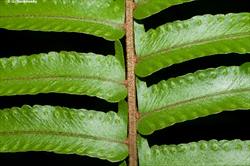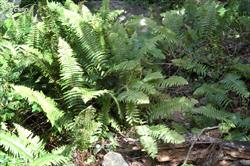Nephrolepidaceae
Australian Tropical Ferns and Lycophytes - Online edition
Nephrolepis hirsutula



Nephrolepis hirsutula (G.Forst.) C.Presl
Link to Australian Plant Name Index for publication details and synonyms: https://id.biodiversity.org.au/name/apni/82175
Sword Fern or Fishbone Fern
Stolons and basal portions of stipes densely scaly; scales lanceolate, either pale brown or red-brown with pale margins, and bearing few to many short or long marginal cilia. Fronds to 1.2 m long; rachis with dense rusty scales consisting of a small base giving rise to many short hair-like processes and 1 elongate branch with marginal cilia. Pinnae closely spaced, usually with an elongate narrowly triangular basal auricle. Sterile pinnae 20–110 mm long, 10–20 mm wide, with scattered scales; upper midrib covered with scales or simple hairs; margins crenate towards acute apex (except in basal pinnae). Fertile pinnae 35–115 mm long, 5–14 mm wide; margins more deeply crenate. Sori submarginal; indusium reniform.
Occurs along the NE and E QLD coast and hinterland from Lizard Island to Stradbroke Island. Also recorded from the Kakadu area of NT. Also Pantropical.
Terrestrial, lithophytic and occasionally epiphytic fern in a variety of rainforests, rainforest margins and open forests. In inland areas it is usually found nears creeks or gorges.
Indigenous and naturalised populations of this species occur in QLD. This is a widely cultivated garden fern. It may be invasive in greenhouse and garden situations.
Readily cultivated in a wide range of situations. Can be a weed.
Nephrolepis hirsutula can be distinguished from other Australian Nephrolepis by the presence of a triangular auricle on the acroscopic side of the pinnae bases combined with hairs being absent on the upper costa and sori being submarginal.
Key to Australian Nephrolepis spp.:
1a. Sori linear with a linear indusium and borne on margin; pinnae with entire margins = Nephrolepis acutifolia
1b. Sori round or kidney-shaped with a kidney-shaped indusium and borne supramedially to medially, each on the end of a vein, margins ~ crenate = 2
2a. Pinnae with an obtuse apex, less than 50 mm long = 3
2b. Pinnae with an acute to attenuate apex, greater than 50 mm long = 4
3a. Rachis with scales, rarely hairy, basal auricles of pinnae overlapping rachis = Nephrolepis cordifolia
3b. Rachis with hairs, rarely scaley, basal auricles of pinnae not usually overlapping rachis = Nephrolepis arida
4a. Pinnae with an acroscopic basal auricle; all parts hirsute = 5
4b. Pinnae lacking a distinct acroscopic basal auricle, indumentum sparse = 5
5a. Hairs on upper side of costae absent; rachis scales rufous, with strongly dentate acumen; sori submarginal = Nephrolepis hirsutula
5b. Hairs on upper side of costa present; rachis scales hyaline or light brown (rarely rufous), with nearly entire acumen; sori submedial = Nephrolepis brownii
6a. Sori borne close to margin, stolons densely scaly = Nephrolepis biserrata
6b Sori borne medially, stolons green with few scales = Nephrolepis obliterata
Field AR, Quinn CJ, Zich FA (2022) Australian Tropical Ferns and Lycophytes. apps.lucidcentral.org/fern/text/intro/index.htm (accessed online INSERT DATE).
Field AR, Quinn CJ, Zich FA (2022) ‘Platycerium superbum’, in Australian Tropical Ferns and Lycophytes. apps.lucidcentral.org/fern/text/entities/platycerium_superbum.htm (accessed online INSERT DATE).







